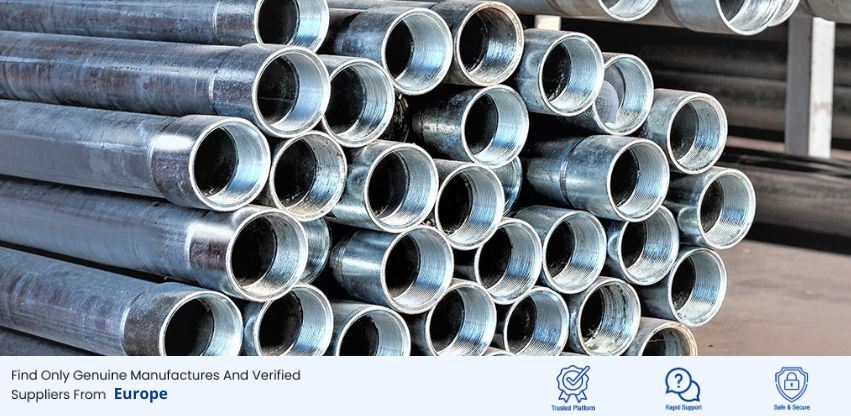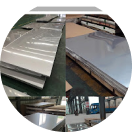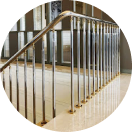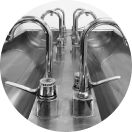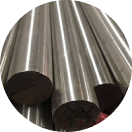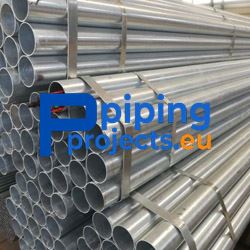Galvanized Pipe Manufacturers, Suppliers & Exporters in Europe - PipingProjects.eu
PipingProjects.eu is one of the leading Galvanized Pipe Manufacturer in Europe. Galvanized Pipes are metallic tubes primarily comprised of iron and other elements, including manganese and aluminum. Praised for their robustness and longevity, Galvanized Pipes exhibit superior strength compared to traditional iron pipes. As a reputable Galvanized Pipe Supplier in Europe, we are dedicated to providing high-quality products that adhere to rigorous industry standards. Our commitment ensures the reliability and durability of Galvanized Pipes, making them well-suited for a diverse range of applications.
What are Galvanized Pipe?
Galvanized Pipes are steel pipes that have undergone a galvanization process, where a protective layer of zinc is applied to the surface of the pipe. This process is designed to prevent corrosion and extend the lifespan of the steel pipe, especially when it is exposed to harsh environmental conditions.
Galvanized Pipes are commonly used in a variety of applications, including plumbing, construction, and industrial settings. They are known for their corrosion resistance, durability, and ability to withstand harsh conditions. Additionally, the galvanized coating provides a uniform finish, contributing to the aesthetic appeal of the pipes.
Top leading Manufacturing Companies
Is Galvanized Steel Pipe suitable for use with natural gas?
The question of whether Galvanized Pipes can be used for natural gas has been a long-standing debate. The sulfur present in natural gas reacts with the zinc in Galvanized Pipes, causing it to flake away. Consequently, many have opted for black iron pipes without zinc. However, advancements in natural gas refining have improved the quality, making Galvanized Pipes a viable option.
The International Fuel Gas Code (IFGC) permits the use of galvanized steel tubes in natural gas delivery systems, provided they meet all the standards outlined in ASTM A53/A53m-05. As model codes, decisions on using one type of pipe over another for natural gas applications are typically made by local jurisdictions.
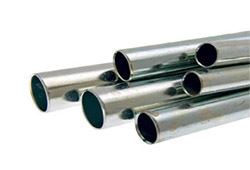
Galvanized Pipe
Galvanized Pipe - Specifications
- Product : Galvanized Pipe
- Size : 1/8″NB TO 48″NB IN
- Schedule : SCH20, SCH30, SCH40, STD, SCH80, XS, SCH60, SCH80, SCH120, SCH140, SCH160, XXS
- Forms : Seamless / ERW / Welded / Fabricated / LSAW Pipes
- Standards : JIS, AISI, ASME, ASTM, AMS, GB, DIN, EN, GOST
- Method : Hot Rolled & Cold Rolled

Trusted
Supplier

Genuine
Product

Easy
purchase
What are the advantages of using Galvanized Pipes?
- Galvanized steel pipes offer several advantages that contribute to their widespread use in various applications. Firstly, their primary advantage lies in their exceptional corrosion resistance. The zinc coating applied during the galvanization process acts as a protective barrier, preventing rust and corrosion, thereby significantly extending the lifespan of the pipes. This makes galvanized steel pipes particularly suitable for outdoor applications, such as fencing, water supply systems, and construction projects.
- Galvanized steel pipes are cost-effective and low-maintenance. While the initial investment may be slightly higher than that of untreated steel pipes, the long-term benefits outweigh the costs. The durability and resistance to corrosion reduce the need for frequent replacements or repairs, leading to overall savings in terms of maintenance and replacement expenses. These advantages, coupled with their versatility, make galvanized steel pipes a preferred choice in industries ranging from construction to agriculture and plumbing.
Galvanized Pipe Tolerance Chart
Discover the precise chemical composition of Galvanized Pipes, crucial for diverse applications, with insights from a trusted Galvanized Pipe Supplier in Europe, ensuring adherence to quality standards and performance reliability.
Tolerance Chart of Galvanized Pipe
| Class |
Thickness |
Weight |
|
Length |
| Class |
Thickness |
Weight |
|
Length |
| |
|
Single Tube |
Per Load of 10 MT MIN |
Unless otherwise specified |
| Light |
+Not Limited -8% |
+10% -8% |
+7.5% -5% |
4 to 7 Mtrs. |
| Medium & Heavy |
Not Limited -10% |
10% |
+7.5% |
|
Galvanized Pipe Technical Information
Explore the mechanical prowess of Galvanized Pipes, including strength and ductility, provided by a reputable Galvanized Pipe Manufacturer in Europe, ensuring top-tier quality for a range of industrial applications.
Technical Information of Galvanized Pipe
| Nominal Mass of Steel Tube |
Wall Thickness |
Outside Diameter (OD) |
Nominal Bore Class |
Sockets |
| Plain End |
Screwed Socketed |
max |
min |
min OD |
min length |
| KG/MTR |
MRS/MT |
KG/MTR |
MTRS/MT |
MM |
SWG |
MM |
MM |
MM |
INCH |
MM |
MM |
| 0.947 |
1056 |
0.956 |
1046 |
2.0 |
14 |
21.4 |
21.0 |
15L |
0.50 |
27.0 |
37.0 |
| 121 |
826 |
122 |
820 |
26 |
12 |
21.8 |
21.0 |
15M |
0.50 |
27.0 |
37.0 |
| 144 |
694 |
145 |
6go |
32 |
10 |
21.8 |
21.0 |
15H |
0.50 |
27.0 |
37.0 |
| 1.38 |
725 |
139 |
719 |
23 |
13 |
26.9 |
26.4 |
20L |
0.75 |
325 |
39.0 |
| 156 |
641 |
157 |
637 |
26 |
12 |
27.3 |
26.5 |
20M |
0.75 |
325 |
39.0 |
| 187 |
535 |
188 |
532 |
32 |
10 |
27.3 |
26.5 |
20H |
0.75 |
325 |
39.0 |
| 1.98 |
505 |
2.00 |
500 |
2.6 |
12 |
33.8 |
33.2 |
25L |
100 |
395 |
46.0 |
| 241 |
415 |
2.43 |
412 |
32 |
10 |
34.2 |
33.3 |
25M |
100 |
395 |
46.0 |
| 2.93 |
341 |
2.95 |
339 |
40 |
8 |
34.2 |
33-3 |
25H |
100 |
395 |
46.0 |
| 254 |
394 |
2.57 |
389 |
26 |
12 |
42.5 |
41.9 |
32L |
125 |
49.0 |
510 |
| 3.10 |
323 |
313 |
319 |
32 |
10 |
42.9 |
42.0 |
32M |
125 |
49.0 |
51.0 |
| 379 |
264 |
3.82 |
262 |
40 |
8 |
42.5 |
419 |
32H |
125 |
49.0 |
510 |
| 323 |
310 |
3.27 |
306 |
29 |
11 |
48.4 |
47.8 |
40L |
150 |
56.0 |
510 |
| 356 |
281 |
3.60 |
278 |
32 |
10 |
48.8 |
47.9 |
40M |
150 |
56.0 |
510 |
| 4.37 |
229 |
441 |
227 |
40 |
8 |
48.8 |
479 |
40H |
1.50 |
56.0 |
51.0 |
| 4.08 |
245 |
415 |
241 |
29 |
11 |
60.2 |
59.6 |
50L |
2.00 |
68.0 |
60.0 |
| 503 |
199 |
5.10 |
196 |
36 |
9 |
60.8 |
597 |
50M |
2.00 |
68.0 |
60.0 |
| 6.19 |
162 |
5.26 |
160 |
45 |
7 |
60.8 |
597 |
50H |
2.00 |
68.0 |
60.0 |
| 571 |
175 |
583 |
172 |
32 |
10 |
76.0 |
752 |
651 |
2.50 |
84.0 |
6g.o |
| 6.42 |
156 |
6.54 |
153 |
36 |
9 |
76.6 |
753 |
65M |
2.50 |
84.0 |
69.0 |
Different types of Galvanized Steel Pipe?
Galvanized conduit encompasses various types of pipes, each influenced by factors such as material composition, size, color, shape, and manufacturing processes. This diverse range includes options like lowes Galvanized Pipe, welding Galvanized Pipe, and black Galvanized Pipe. The distinct compositions of zinc and manufacturing techniques associated with each type make them suitable for specific applications and industries.
One noteworthy example is the schedule 40 galvanized steel pipe, distinguished by its unique HDG or hot-dip galvanizing process. This method tightly bonds the zinc to the steel, providing superior corrosion protection. Pipes undergoing this process are highly resilient in demanding environments. Additionally, 4-inch Galvanized Pipes stand out as versatile solutions with widespread applicability across various sectors, owing to their durability and corrosion resistance. These variations in galvanized conduit cater to diverse needs in construction, plumbing, and other industries, offering tailored options for specific purposes.
Can Galvanized Pipes be used for Plumbing?
As a leading Galvanized Pipe Manufacturer in Europe, we pride ourselves on providing high-quality pipes tailored for diverse plumbing needs. Our Galvanized Pipes undergo a meticulous manufacturing process that involves coating the steel with a protective layer of zinc, ensuring superior corrosion resistance and durability.
-
Corrosion Resistance: Galvanized Pipes are coated with zinc, providing effective corrosion resistance, which is crucial for plumbing systems.
-
Durable Material: The zinc coating enhances the durability of Galvanized Pipes, making them suitable for both indoor and outdoor plumbing installations.
-
Longevity: Galvanized Pipes have a relatively long lifespan, contributing to their enduring use in plumbing systems.
-
Versatility: They are versatile and can be used for various plumbing purposes, including water supply lines and drainage systems.
-
Cost-Effective: Galvanized Pipes are often more cost-effective than alternatives, making them a budget-friendly choice for plumbing projects.
-
Easy Installation: These pipes are relatively easy to install, making them convenient for plumbing professionals and DIY enthusiasts.
-
Compatibility: Galvanized Pipes can be connected to existing plumbing systems, providing compatibility in older constructions where they were commonly used.
Advantages of using Galvanized Pipes
- Galvanized Pipes offer a range of advantages, making them a popular choice in various applications. One notable advantage is their exceptional corrosion resistance. The process of galvanization involves coating the steel pipes with a layer of zinc, forming a protective barrier against rust and corrosion. This attribute makes Galvanized Pipes highly durable, particularly in environments where exposure to moisture or harsh weather conditions is a concern. As a result, they prove invaluable in outdoor applications, water supply systems, and structural frameworks.
- Another significant advantage of Galvanized Pipes is their longevity. The zinc coating not only provides corrosion resistance but also contributes to an extended lifespan for the pipes. This durability is crucial for plumbing and construction projects, ensuring that the pipes maintain their structural integrity over an extended period. Additionally, Galvanized Pipes are known for their versatility, accommodating various plumbing needs, including water distribution, drainage systems, and gas lines. Their adaptability to different applications adds to their appeal in diverse industrial and residential settings.
- In terms of cost-effectiveness, Galvanized Pipes offer an economical solution without compromising on quality. The initial investment in Galvanized Pipes is often justified by their extended service life and the reduced need for maintenance or replacements. This cost-effectiveness, combined with their robustness and corrosion resistance, positions Galvanized Pipes as a reliable and practical choice for a wide range of construction and plumbing applications.
Various Types of Galvanized Pipe We Supply
PipingProjects.eu is a leading Galvanized Pipe Supplier in Europe. We supply different types of Galvanized Pipes to meet diverse industrial needs with superior quality and precision.
Are Galvanized Pipes prone to Rusting or Corrosion?
- Galvanized Pipes are generally resistant to rust and corrosion, which is one of their primary advantages. The galvanization process involves coating the steel pipes with a layer of zinc, creating a protective barrier against environmental elements. This zinc coating serves as a sacrificial anode, meaning it corrodes before the underlying steel does. As a result, even if the outer zinc layer is compromised over time, the steel core remains shielded, mitigating the risk of rust and corrosion. This resistance is particularly beneficial in plumbing systems, where exposure to moisture is common.
- However, it's essential to acknowledge that Galvanized Pipes may still be prone to corrosion under certain conditions. Over an extended period, especially in aggressive environments or in the presence of acidic or alkaline water, the zinc coating may wear away, exposing the steel to potential corrosion. High temperatures can also accelerate the deterioration of the zinc layer. In instances where Galvanized Pipes are used for plumbing, factors such as water quality, pH levels, and the age of the pipes should be considered to assess the potential risk of corrosion.
- In summary, while Galvanized Pipes provide robust resistance to rust and corrosion, their long-term performance depends on various factors. Regular inspections and maintenance can help identify and address any potential issues, ensuring the continued durability of Galvanized Pipes in diverse applications.S
Manufacturing Process of Galvanized Pipes
Galvanized Pipe is produced in seven steps. It manufactures a wide range of shapes, goods, and parts, ranging from Galvanized Pipe and Coil.
- Step 1 : Raw Material Selection
To begin the process of creating alloy steel, raw materials such as iron ore and other elements including nickel, chromium, and molybdenum are carefully selected. The choice of alloying elements depends on the specific properties that the alloy steel is intended to possess.
- Step 2 : Smelting and Melting
Once the raw materials have been selected, they are smelted in a furnace to create a molten metal alloy. The composition of the alloy is closely monitored and controlled to achieve the desired grade of alloy steel.
- Step 3 : Forming
After the molten alloy steel has been produced, it is cast into different shapes and forms, depending on its intended use. The most common shapes include slabs, billets, blooms, or ingots.
- Step 4 : Primary & Secondary Steelmaking
The subsequent step is primary steelmaking, which can be accomplished through different methods such as the Basic Oxygen Furnace (BOF) or the Electric Arc Furnace (EAF). At this stage, impurities like carbon are eliminated to achieve the desired chemical composition.
- Step 5 : Casting
The molten alloy steel is then cast into semi-finished forms, which can take the shape of plates, sheets, bars, or other forms. Continuous casting or ingot casting methods are usually employed for this purpose.
- Step 6 : Hot Rolling
In the case of products like Galvanized Pipes, the semi-finished castings are hot-rolled to achieve the desired thickness and shape. During this process, the thickness of the castings is reduced while improving their mechanical properties.
- Step 7 : Cold Rolling and Annealing
In the case of specific alloy steel products such as thin sheets and coils, cold rolling is employed to further reduce the thickness and enhance surface finish. To relieve stresses and enhance corrosion resistance, annealing is frequently performed.
